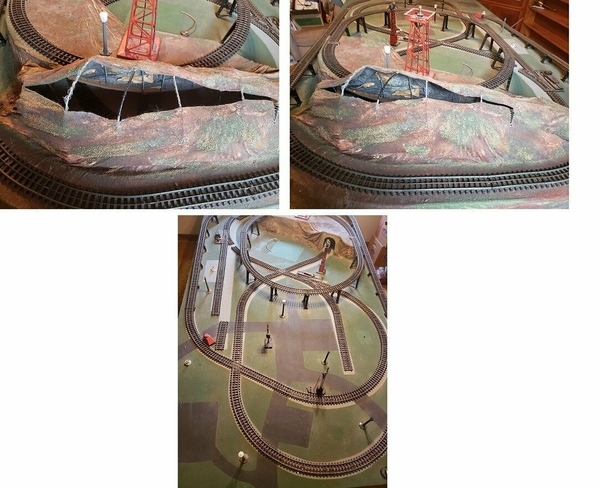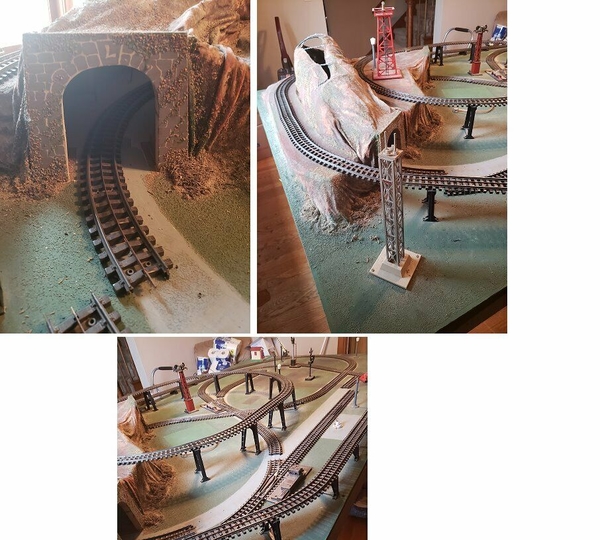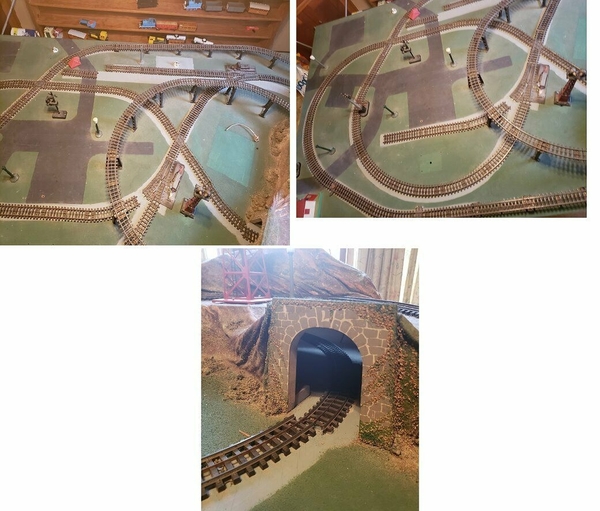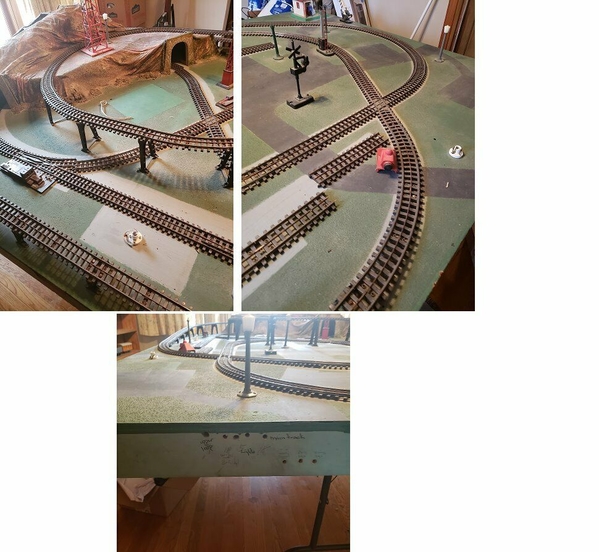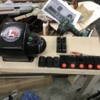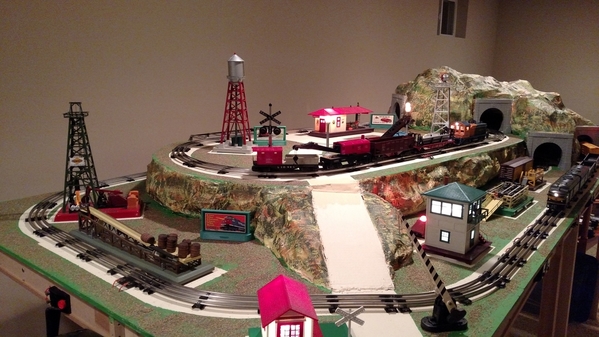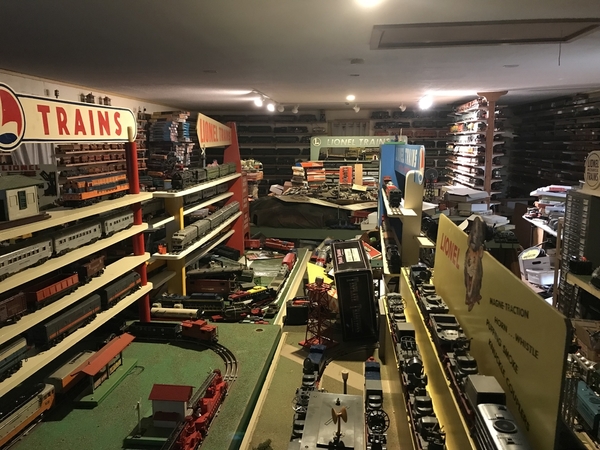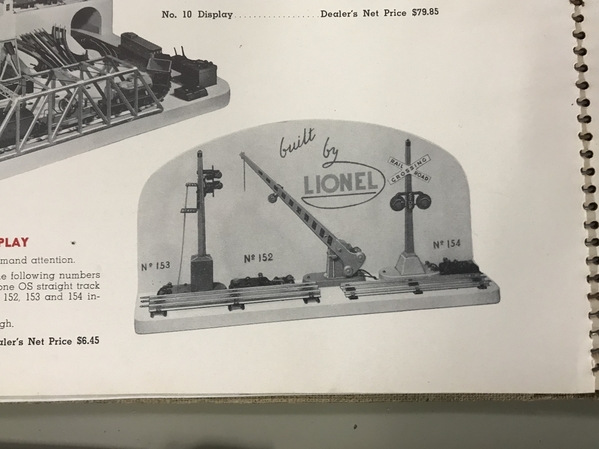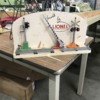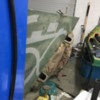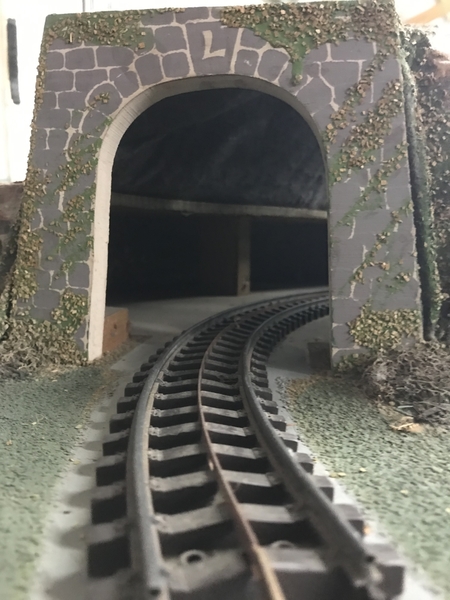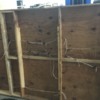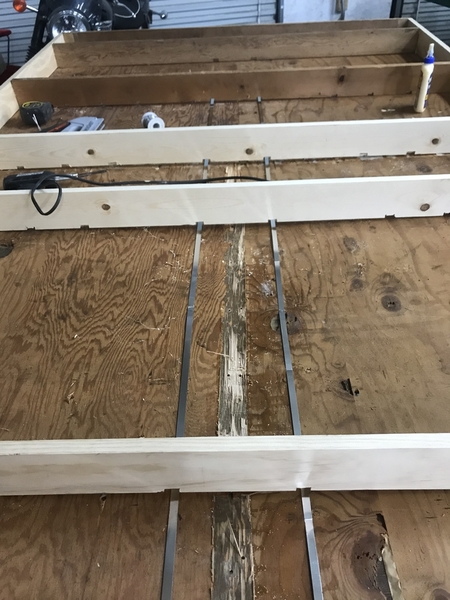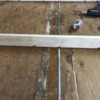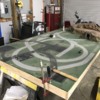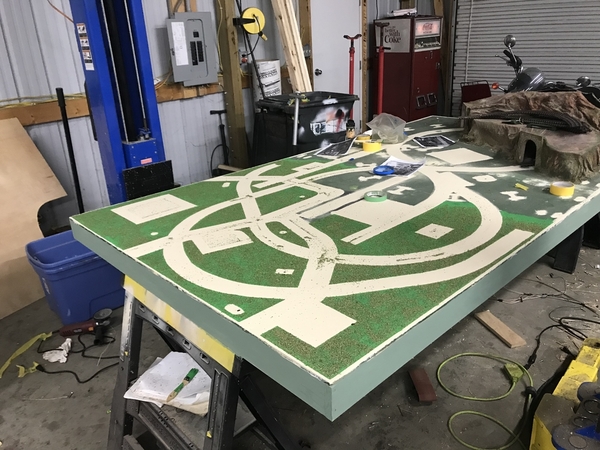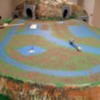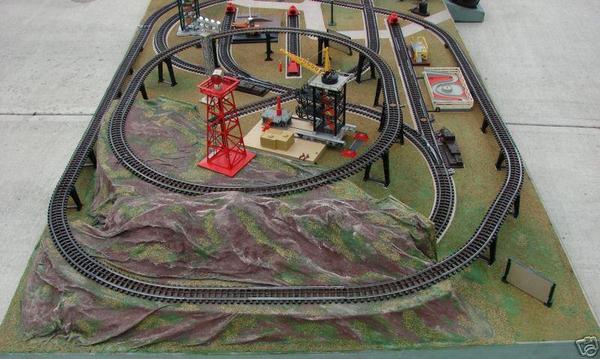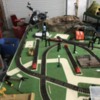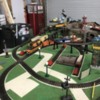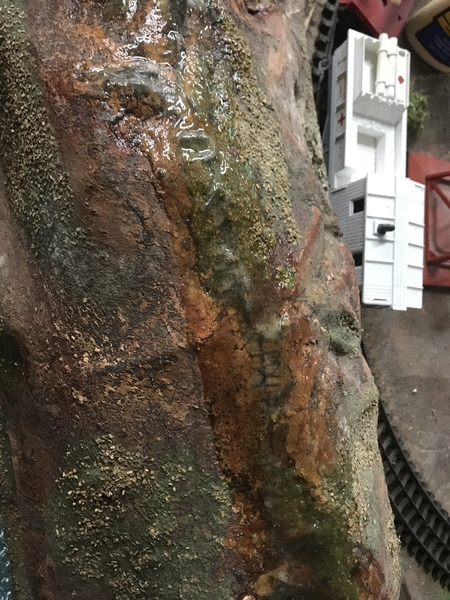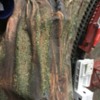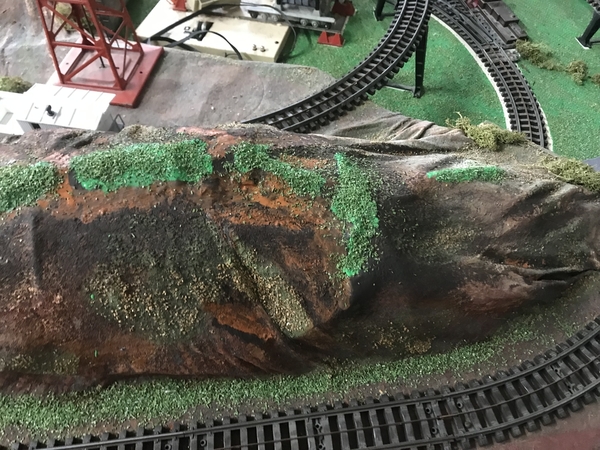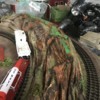Starting restoration of D291 Lionel dealer layout from 1960 soon
Replies sorted oldest to newest
Very cool! Looking forward to seeing pics of your progress.
Peter
VERY COOL!!
Neat-o! This thread ought to be fun!
Andre
Nice to see you back Rick. Looks like another great Lionel dealer display on it's way back to life! ![]()
Some recent additions to my D-105.
Attachments
Awesome! I've been thinking about building a modern day version of this exact layout (D-291). Don't know when, or if, I'll ever get one done. But at least I'm thinking about it! ![]()
John you have done a beautiful job on that you really got the technique on the scenery
Running out of room again time to get another building !! Hope to make it look like a big toy store of the 1950’s and a place to entertain local or visiting train guys
Jagrick posted:John you have done a beautiful job on that you really got the technique on the scenery
Thanks! Have a few minor things left on this one and then...done. Maybe. ![]()
Playing around with ideas for the next display. Thinking of a Super O layout with a Military and Space theme. Always one of my favorites. There were a few of those done by Lionel but may actually design my own.
amazing stuff!
Nice. These table and counter top type displays in your pictures above are quite eye catching.
Only to be able to go back in time and stroll into a hobby shop or train store and see them live and in person. ![]()
I think that the present day Lionel should do something like this with the new Fastrack. They could offer layouts built using the classic display track plans but with the new Fastrack for sale to dealers, but also to the general public. They could add modern buildings and accessories as appropriate. What do the rest of you think of this idea?
tncentrr posted:I think that the present day Lionel should do something like this with the new Fastrack. They could offer layouts built using the classic display track plans but with the new Fastrack for sale to dealers, but also to the general public. They could add modern buildings and accessories as appropriate. What do the rest of you think of this idea?
It's a good thought although I wonder if there would be any interest on Lionel's part. One of the advantages of a display (even a small one) is that customers can see the potential of building something beyond a small loop on the floor. And as you mention it also markets signals, accessories and buildings.
Speaking of FasTrak, there have been a few threads here where hobbyists built older display style layouts substituting Fastrak for tin track. Easy to do.

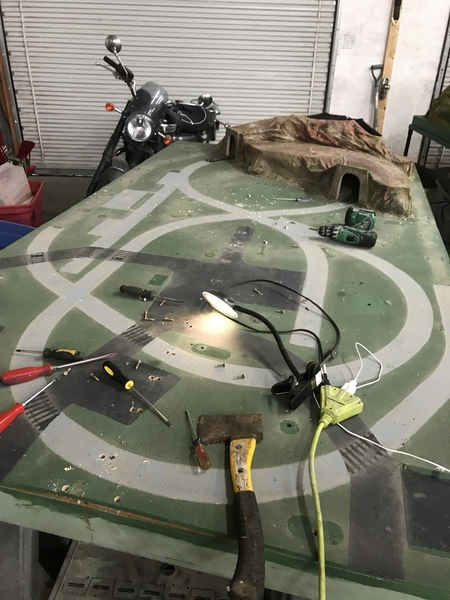


 This layout had been cut into 3 pieces. I am going to replace 60% of the framing where it was cut and have to paint match and fix the tunnel but should look great when done. Will wire by reinstalling the bus bars which are missing and correct routing and control panel. Felt mountain was cut looks like, probably because it had collapsed so well add an internal wood/screen frame for support and use wool thread and hide glue to heal it back together
This layout had been cut into 3 pieces. I am going to replace 60% of the framing where it was cut and have to paint match and fix the tunnel but should look great when done. Will wire by reinstalling the bus bars which are missing and correct routing and control panel. Felt mountain was cut looks like, probably because it had collapsed so well add an internal wood/screen frame for support and use wool thread and hide glue to heal it back together
Attachments
The double folded loop is an interesting way to get a long run on a table of this size.
When Lionell made these displays, they would first paint the plywood with a light colored base paint, usually a light brown. Then they would use a large silk screen to apply the green paint and leave the areas where the accessories, track, trestles, lamps etc. would go to hasten the assembly process . The screens were usually slightly smaller than the plywood board so the edge would be left the color of the base. So when I restore these or even reproduce them I duplicate this feature to stay true to the construction characteristics
What a great project. Can't wait to see the finished product.
Looks great as usual. Do you use Lionel 919 grass? Or maybe dyed saw dust?
Use original 919 grass I haven’t found anything else even close
Jagrick posted:Use original 919 grass I haven’t found anything else even close
So you must be careful to sweep up the excess 919 grass and not loose any as it must be hard to come by... no?![]()
![]()
Definitely a finite supply so I use a dedicated little dust buster to recover as much as possible
Jagrick posted:Definitely a finite supply so I use a dedicated little dust buster to recover as much as possible
Same here. I picked up three large bags of the stuff a few years ago and have managed to make it last.
Attachments
Jagrick posted:When Lionell made these displays, they would first paint the plywood with a light colored base paint, usually a light brown. Then they would use a large silk screen to apply the green paint and leave the areas where the accessories, track, trestles, lamps etc. would go to hasten the assembly process . The screens were usually slightly smaller than the plywood board so the edge would be left the color of the base. So when I restore these or even reproduce them I duplicate this feature to stay true to the construction characteristics
I never noticed that detail before. Granted, I've never seen an authentic display layout in person, but I studied pictures of them online and on this forum quite a bit. Great work as always.
The other thing I'm picking up that you do, that seems to follow the originals, is painting the table top the medium green color, while the sides are the more muted, blue-ish/gray-ish green color. I sometimes see them painted entirely medium green or entirely blue-ish/gray-ish green. Were there certain times that different paint schemes were used? Or were some of these examples repainted, without taking the same attention to detail as you?
Attachments
the color for the frame did change, it was a dark green earlier post war and went to the lighter green in the late late 50's/early 60's. But there were variations, the first display in 1948 (10M) was a cream color and the D11 was yellow frame. The base color tended to be a light brown color later or early a off white. Then they used masonite in some cases and just screened with the green color ald let the masonite brown be the background color. The green for the grass and colors for the base and mountains also changed, early the green was brighter as were the mountain colors then they changed to darker earthy tones with a less bright green. You will also see differing density of grass probably depending on who was applying, how late in the day etc. I probably put more grass on than used most of the time but I am trying to cover a blemish, previous damage or just want a more uniform look. In one instance, the disappearing train layout the sides were left natural wood in ones I have seen and the construction of the frame more complex with router work required.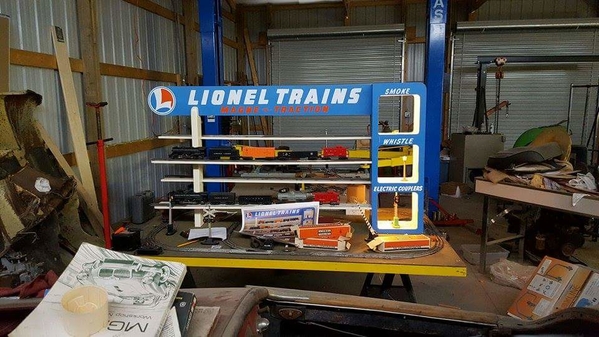
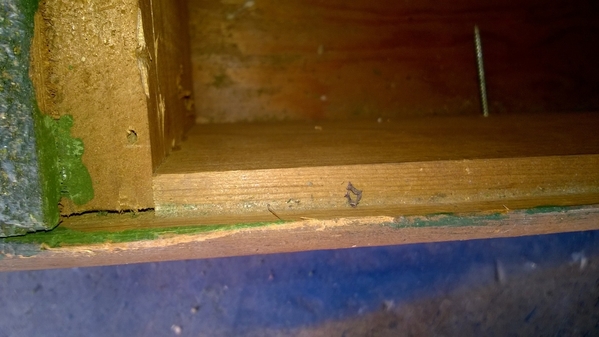
Attachments
Rick has covered it well. My comment on colors on the old displays that pop up here and there is that you frequently are seeing significant amounts of fading so tough to judge in some cases. CTT did a special issue on displays a few years ago and it was pretty obvious how one display differed from another even from the same year. Some of these were displayed in stores or hobby shops while others were in private homes in a windowless basement.
When I did my D-105 I played around with the base color for the track bed and roads. Originally it was too white and finally found a cream that looked good. And for my “Lionel green” I used Behr’s Park Picnic which I think works well.
https://www.behr.com/consumer/ColorDetailView/P390-7
I took in a sample of clean paint from a protected area and had them color match, who knew there were so many greens!!
Jagrick posted:Use original 919 grass I haven’t found anything else even close
Just curious here, but any idea of what type of material the original 919 grass is? ![]()
the onr on left is later "realistc" and on the right (albeit restored) the earlier colors, a carry over style from prewar decorating
it looks like small chips vs sawdust saw unsure of manufacturing process and I had not been able to duplicate. It is wood
Best thing I ever did on paint colors was use the small sample sizes at Home Depot to test and evaluate what looked best. Back when I was in the masking and painting stage I think I visited my local HD 3 or 4 times a week! The paint guys knew me. ![]()
Really looks great !
Interesting to see heavy use of #90 switches on this one. A reflection of the type of operating accessories.
Great work. I especially like the look of the grass with that off white shade for the track and road beds.
Good luck on the mountain/tunnel "surgery."
color matched to original paint so has a new look vs. worn, did this by uncovering areas that had been protected from dirt, etc. Using original Lionel grass helps alot as well. Was able to use all of original track but did replace switches and a few pieces of track lost. New bus bars (I make those out of some really big sheets of tinned sheet metal I have and rewiring (all original was gone) as done originally and will have operating block system Lionel used to run two trains on the large lower loop. Temporarily put the power to it last night prior to starting mountain repair and neat to see it running again in who knows how long!
JAGRICK,
Another great restoration/recreation! I love the mountain surgery you performed. Dr. DeBakey would be proud of those sutures.
I will try to answer some of the questions posted previously. Lionel used the "prewar" style of mountain painting from 1952 until 1954. 1955 was the first year that they went to the more subdued "realistic" style. The prewar style used fanciful designs painted on the felt with bright colors of casein paints. No patches of 919 grass were applied to this style of mountain landscaping, although some examples show lichen affixed. In 1955, Lionel switched to a more subdued style, of which the D-291 is an example. Construction was basically the same, but the paint colors used and the manner of finishing was different. In this style, patches of grass were simulated by using 919 grass affixed to green casein paint. You can clearly see this in the photos of JAGRICK's layout mountain. The colors were earth tone casein paints in raw umber, burnt umber, burnt sienna etc. The same tan paint used on the base was used as a highlight to pick out "rocks" etc. Lichen was then affixed to the mountain in various places. Importantly, the raw gray felt color was left to show through in spots. Getting the correct look is not easy. Even the manner of affixing the lichen is important. Lionel did not just "throw" the lichen in place, but affixed it (with staples on the base, glue on the mountains) in such a manner to make the individual clumps appear to be growing or standing up.
In most all cases, the construction of the mountains on these displays were made using a gray wool felt. Sticks of 1" X 1" wood were used to support wire screen (early layouts from 1952 - 1954) or brown wrapping paper (later layouts from 1955 onward with exceptions). Over this the felt, dipped into a hide glue (Lionel used a hot "fish" glue used as an adhesive for bonding action leather in pipe organs and still available today from Organ Supply in Erie, PA) was draped. Additional clumps of brown paper, or even newspaper were used to build up the mountain here or there. JAGRICK's photos seem to show wire "hoops" supporting the mountain on this D-291. If they are original, it is the first time I have seen such construction on a Lionel display. Very few layouts used mountains made from Celastic, a colloidal plastic impregnated fabric originally used in the shoe industry and adapted for theater stage props and masks. The large 8' X 16' display Lionel built for the Great Escape ("Story Land") in Lake George, NY, now in the collection of Ed Dougherty is an example. The modified D-264 that went to Moscow is another. Celastic was also used to construct the mountains on the Super O Showroom layout and may have been used on the 1949 Showroom display as well. These mountains were much more permanent and required a base coat of tan paint before adding the various landscape colors.
The sides of the layouts and control panels from 1952 - 1954 were painted with a gloss oil based kelly green paint. In 1955, the color changed to the greenish gray and was a semi-gloss oil based paint.
There really is no substitute for Lionel 919 grass. The sawdust is of a coarse texture and has a unique faded green color. In constructing my D-165 recreation, I think I used something like 8 bags. I carefully mixed the bags together before starting because every bag had a slightly different hue. Originally, it was affixed by sprinkling it over wet, tacky oil based paint. Today, using latex based paints, it is necessary to use a retarding agent added to the paint in order to prevent the latex paint from setting too fast. I used Benjamin Moore paints and a retarder/extender from Coronado Paints when I built my layout. 
Attachments
Frank G. posted:JAGRICK,
Another great restoration/recreation! I love the mountain surgery you performed. Dr. DeBakey would be proud of those sutures.
I will try to answer some of the questions posted previously. Lionel used the "prewar" style of mountain painting from 1952 until 1954. 1955 was the first year that they went to the more subdued "realistic" style. The prewar style used fanciful designs painted on the felt with bright colors of casein paints. No patches of 919 grass were applied to this style of mountain landscaping, although some examples show lichen affixed. In 1955, Lionel switched to a more subdued style, of which the D-291 is an example. Construction was basically the same, but the paint colors used and the manner of finishing was different. In this style, patches of grass were simulated by using 919 grass affixed to green casein paint. You can clearly see this in the photos of JAGRICK's layout mountain. The colors were earth tone casein paints in raw umber, burnt umber, burnt sienna etc. The same tan paint used on the base was used as a highlight to pick out "rocks" etc. Lichen was then affixed to the mountain in various places. Importantly, the raw gray felt color was left to show through in spots. Getting the correct look is not easy. Even the manner of affixing the lichen is important. Lionel did not just "throw" the lichen in place, but affixed it (with staples on the base, glue on the mountains) in such a manner to make the individual clumps appear to be growing or standing up.
In most all cases, the construction of the mountains on these displays were made using a gray wool felt. Sticks of 1" X 1" wood were used to support wire screen (early layouts from 1952 - 1954) or brown wrapping paper (later layouts from 1955 onward with exceptions). Over this the felt, dipped into a hide glue (Lionel used a hot "fish" glue used as an adhesive for bonding action leather in pipe organs and still available today from Organ Supply in Erie, PA) was draped. Additional clumps of brown paper, or even newspaper were used to build up the mountain here or there. JAGRICK's photos seem to show wire "hoops" supporting the mountain on this D-291. If they are original, it is the first time I have seen such construction on a Lionel display. Very few layouts used mountains made from Celastic, a colloidal plastic impregnated fabric originally used in the shoe industry and adapted for theater stage props and masks. The large 8' X 16' display Lionel built for the Great Escape ("Story Land") in Lake George, NY, now in the collection of Ed Dougherty is an example. The modified D-264 that went to Moscow is another. Celastic was also used to construct the mountains on the Super O Showroom layout and may have been used on the 1949 Showroom display as well. These mountains were much more permanent and required a base coat of tan paint before adding the various landscape colors.
The sides of the layouts and control panels from 1952 - 1954 were painted with a gloss oil based kelly green paint. In 1955, the color changed to the greenish gray and was a semi-gloss oil based paint.
There really is no substitute for Lionel 919 grass. The sawdust is of a coarse texture and has a unique faded green color. In constructing my D-165 recreation, I think I used something like 8 bags. I carefully mixed the bags together before starting because every bag had a slightly different hue. Originally, it was affixed by sprinkling it over wet, tacky oil based paint. Today, using latex based paints, it is necessary to use a retarding agent added to the paint in order to prevent the latex paint from setting too fast. I used Benjamin Moore paints and a retarder/extender from Coronado Paints when I built my layout.
The hoops were someones attempt to support. Probably the mountain collapsed on itself as this one would have been held up by the heavy craft paper initially during construction and then once the fish glue was set, the strength of the glue which crystallizes and becomes rigid( however these will soften with chronic humidity and can collapse). I removed the hoops and placed a small amount of wire mesh (screen door material) for support and this was stapled in place inside the tunnel. I then placed several individual sutures through the felt and into the mesh to give it some integrity. Then using a continuous lembert or ford interlocking pattern carefully pulled the edges together. I then applied and worked into the felt hide glue and had to make one small felt patch that had torn out. Once dry will apply the casein paint and blend in as well as possible.
Maiden run and the block system is wired up as well will show that later
That works great - really cool ![]()
making trains stop and start by themselves gets real attention.
there is a lot you can do with relay technology. the non-derailing feature on switches is great for adding interest also.
Beautiful work as usual! That Super O looks great. The main line handles both of those trains without it feeling too crowded.
F&G RY posted:making trains stop and start by themselves gets real attention.
there is a lot you can do with relay technology. the non-derailing feature on switches is great for adding interest also.
All done without relays. Simple lionel wiring and insulated rails
The insulated rail is a trigger. What did you use to stop the train? A 190C contact-er would do it. Is it all done by just making or breaking common?
Just by a large insulated section track of the common or outside rails: both outside rails are isolated and when the moving train hits the standard insulated single section it completes the circuit and the train moves off. There is also a switch under the panel: standard 394C that can be used to complete the circuit as well so just a single train can be operated as well.
You guys are so cool. I like it!
Love the video.....spectacular restoration......the New Haven F3s from ‘58 was my 1st Lionel set......
Peter






